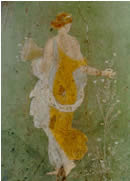 |
Spring
goddess Roman fresco, Pompeii |
The spring equinox is one of two days in the year when day and night are equal, the exact moment of which varies according to geographical location (hence Shunbun-no-hi, the festival of the equinox in Japan, occurs four days earlier).* It is a day that Pagans celebrate the arrival of spring and honour the goddess that the Anglo-Saxons knew as Eastre or Ostara.**
Commonly depicted in a field of spring grass, she holds an egg in her hand as hares play freely around her feet—an image of abundant fertility. In fact, bunnies and baskets of eggs, the symbols of new life and rebirth commonly associated with Easter, have their origins in this festival—as does the name adopted for the Christian celebration.
In one Pagan legend the goddess magically turns her bird into a hare; thereafter, each spring, the hare brings Ostara a basket of brightly coloured eggs which she shares with children as well as hiding them in the fields to bring new life to the plants. Thus in Pagan tradition, the themes of rebirth and rejuvenation are inspired, not by an otherworldly resurrection, but rather by the wonders of the natural world, a reawakening that has led some believers to choose this time to renew their own aspirations and goals.
*The
wheel of the seasons is reversed in the southern hemisphere; thus at the
time that Pagans in the northern hemisphere are celebrating Ostara, those
in the southern hemisphere are observing Mabon,
the harvest festival associated with the autumnal equinox.
**Some claim that the name can be traced back to Ishtar, the great goddess
of the ancient middle east.